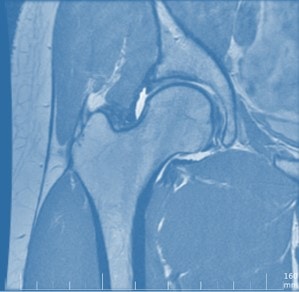My Hip X-ray is Bad so this Means I Need My Hip Replaced, Right? Not So Much…

©Regenexx
Almost all patients and many physicians still treat x-ray and MRI images like the Oracle of Delphi, yet study after study continues to show that there isn’t great correlation between what we see on these images and pain. The most recent entry in this debate was just published last month and it shows how few things on a hip x-ray and MRI correlate well with hip problems. Researchers looked at more than 100 x-rays and MRIs of patients with and without hip arthritis and also gave the patients physical tests of the hip (which makes this study better than many others which just look at a correlation between pain and MRI findings). So the amount of lost cartilage in the joint was the single biggest thing that predicted more pain and less function, right? Wrong. In fact, lost cartilage on the ball (femoral head, the most common place this is seen) didn’t correlate at all with pain and function-only lost cartilage on the socket (acetabulum) was associated with pain and function. In fact, only one of the physical tests correlated with cartilage loss in the socket, while the other two they used did not. More freaky was that x-ray evidence of arthritis had no correlation with pain, function, or physical tests! This is a monster issue, as the decision to replace most hips these days is made only by an x-ray which according to this study is insufficient to see if a patient’s hip is a problem and needs to be replaced. While bone marrow lesions (swelling in the bone) and bone cysts were associated with more pain and reported loss of function, they didn’t correlate with less function on the researcher’s physical hip tests. The upshot? A few years ago many insurance companies, operating on the recommendation of professional societies, started forcing doctors to make hip replacement x-ray and exam based decisions. This study suggests that a hip x-ray is sorely lacking in any ability to determine who needs a hip replacement. As I’ve blogged before, there are many things that cause hip pain such as the SI joint, so regrettably, this may mean that we have a reasonable number of patients undergoing an invasive and risky hip replacement who don’t need the surgery. IMHO all patients who are considering hip replacement surgery need at least a pre – hip replacement MRI (which provides some additional information that at least correlates with pain) and a diagnostic numbing injection into the hip joint which should miraculously relieve the pain and allow good function for the duration of the anesthetic. Based on this study, relying simply on a cursory exam and a hip x-ray to make the decision to replace a hip is a bad idea.

If you have questions or comments about this blog post, please email us at [email protected]
NOTE: This blog post provides general information to help the reader better understand regenerative medicine, musculoskeletal health, and related subjects. All content provided in this blog, website, or any linked materials, including text, graphics, images, patient profiles, outcomes, and information, are not intended and should not be considered or used as a substitute for medical advice, diagnosis, or treatment. Please always consult with a professional and certified healthcare provider to discuss if a treatment is right for you.